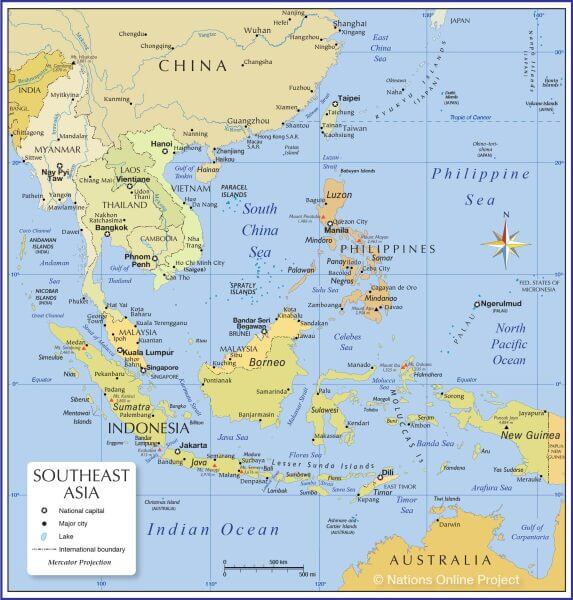#23: Touristing in Southeast AsiaLuang Prabang and Kuala Lumpur and Malacca
Living and working overseas is very different from being there as a tourist. However, living and working overseas means you also get to be a tourist. Traveling to Hong Kong, Kuala Lumpur, Saigon, Singapore or other destinations from Vientiane usually involved short flying times. Here, as described in letters home, are some of the places we were fortunate to visit while we lived in Laos.
May 5, 1991
Luang Prabang, Laos
We spent the last five days in Luang Prabang, the former royal capital. Despite its neglect in recent years, the city is by far more beautiful than Vientiane. The setting is superb: at the confluence of the Mekong and the Man Kan, surrounded by mountains. The latter are like something out of a Chinese painting — giant stegosauruses asleep for centuries, covered with dense forests. Range after range after range of them — steep and sharp and green.
In the rainy season, a double-decker boat plies between Vientiane and Luang Prabang, but the river is too low now, so we had to fly. The plane was a bit small for my taste — the Chinese Y12, a version of the Fokker-Friendship. Happily, both flights were smooth.
The flight leaves Vientiane on its wide, flat plain and heads north. After c. ten minutes, it passes over foothills, and soon the high mountains appear. Far below are small villages — the famous hill tribes, some of whom are still fighting the government. [One reason we had to obtain a Lao Government permit to travel beyond the small area surrounding Vientiane to which foreigners were confined.] As the plane starts to descend, you can’t see an airport, only the mountain flanks right outside the window. Then the pilot banks steeply, and off the wingtip are a small strip and a tiny terminal.
We were met by our guide, who’d been a helicopter pilot during the war, and a driver with an old BMW. As noted above, all travel for foreigners within Laos is restricted. Despite our preference always to travel on our own, we had to take tours organized by Lao Tourism (a little like Russian Intourist, though far gentler).
Our hotel was built by the French about 30 years ago on a small hill at the edge of town. Our room’s balcony featured a view across the city with several ranges of mountains behind.
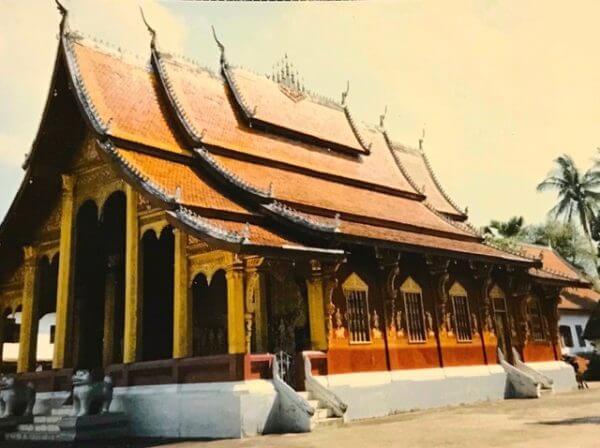 After a quick wash and wc break, we toured two of the main temples. There used to be 60 temples in Luang Prabang, but only about 30 remain, many of them in disrepair. The city has existed for at least 1200 years and was not only the royal capital but also the religious center of the kingdom. The temples are glorious. Most are white, with tiled roofs in orange enamel or plain terra cotta. All the roofs are multi-storied, and every tier has a naga (stylized guardian serpent) on each end. Multiple golden parasols on top of most temples signify they were built by the king. Each temple houses a large, golden statue of Buddha (15 feet or more in height), as well as many smaller ones. The interior pillars and ceilings are usually decorated in gold designs on a vermillion background. It’s very peaceful inside, and the older temples have a palpable atmosphere of holiness and mysticism.
After a quick wash and wc break, we toured two of the main temples. There used to be 60 temples in Luang Prabang, but only about 30 remain, many of them in disrepair. The city has existed for at least 1200 years and was not only the royal capital but also the religious center of the kingdom. The temples are glorious. Most are white, with tiled roofs in orange enamel or plain terra cotta. All the roofs are multi-storied, and every tier has a naga (stylized guardian serpent) on each end. Multiple golden parasols on top of most temples signify they were built by the king. Each temple houses a large, golden statue of Buddha (15 feet or more in height), as well as many smaller ones. The interior pillars and ceilings are usually decorated in gold designs on a vermillion background. It’s very peaceful inside, and the older temples have a palpable atmosphere of holiness and mysticism.
 Afterwards, we sat on the hotel terrace, looking across the valley at a spectacular sunset, drinking the excellent Lao beer and eating Planters potato chips(!).
Afterwards, we sat on the hotel terrace, looking across the valley at a spectacular sunset, drinking the excellent Lao beer and eating Planters potato chips(!).
That night, we discovered that the electricity is only on from 6 to 10 p.m. and again from 4-7:30 a.m. So you better get yourself organized about hot showers and air conditioning. We learned to put bottled water in our room’s freezer, so it would slowly melt when needed, providing cold water. None of the outlets worked, so I just let my hair drip dry. Although it was fairly hot during the afternoon, it cooled off at night because of the altitude. We’d turn on the a.c. from 6-10, then open the windows.
Next day, we were driven to a nearby waterfall — two hours to cover 30 km in a 4-wheel drive Toyota truck over rough dirt roads. There are almost no paved roads in Laos. I’ve been told that Route 13, the main highway connecting Vientiane and Luang Prabang is not paved for most of its 150-km length. All roads are poorly maintained because of the relative lack of equipment and labor (unlike most developing countries, Laos is underpopulated). The waterfall was quite high, perhaps 300 feet. Even in the dry season, the cascade was impressive, not least because it has created the most amazing grottos filled with ferns and other lush tropical plants.
The following day, we went, again by 4-wheel drive, to a Hmong village high in the mountains. This dirt road was even less developed than the one to the falls. Most of the Hmong men were off working in the fields, but the schoolteacher was there, and I was able to talk with him, guide translating. We discussed the importance of education in the villages, as well as customs of marriage and dress, family planning and bringing in goods from outside.
[Two recollections of that day: 1) How uncomfortable I felt, eating the generous hotel-packed lunch while the villagers openly watched, we having been told by the guide not to share. I never, ever want to do that again. 2) That terribly bumpy road was a boon for the rest of my life. When a plane ride gets turbulent, I remind myself that it’s not as bad as that road to the Hmong village, and the vision of the plane riding on a less-bumpy road of air is soothing.]
When we got back to town in the late afternoon, we asked the guide if we could be on our own for a while, and he agreed. We walked around Luang Prabang, ending at the old, colonial Hotel Phoussey, where we stopped for cold drinks. Then back to our hotel on the local version of the tuk-tuk — instead of riding in a “surrey” behind the motorcycle, we were in a side car for two, covered by an old-fashioned buggy top.
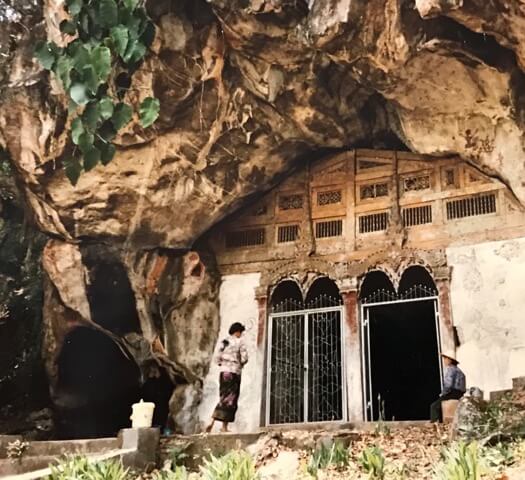 Our next day-trip was to the Buddha Caves, about two hours away by boat on the Mekong. We passed many kinds of watercraft, some powered by motors and others by people. One was ferrying a man and his bicycle downstream! Inside the caves are thousands of statues of Buddha, as small as an inch up to at least six feet high. There’s also a beautiful gate in the higher cave. Everything is in sad disrepair now, but it must have been lovely in its heyday. The king used to come once a year for ceremonies, and you can still see the remains of the platform where he performed these rites. The Australians are going to restore at least the gates, perhaps more.
Our next day-trip was to the Buddha Caves, about two hours away by boat on the Mekong. We passed many kinds of watercraft, some powered by motors and others by people. One was ferrying a man and his bicycle downstream! Inside the caves are thousands of statues of Buddha, as small as an inch up to at least six feet high. There’s also a beautiful gate in the higher cave. Everything is in sad disrepair now, but it must have been lovely in its heyday. The king used to come once a year for ceremonies, and you can still see the remains of the platform where he performed these rites. The Australians are going to restore at least the gates, perhaps more.
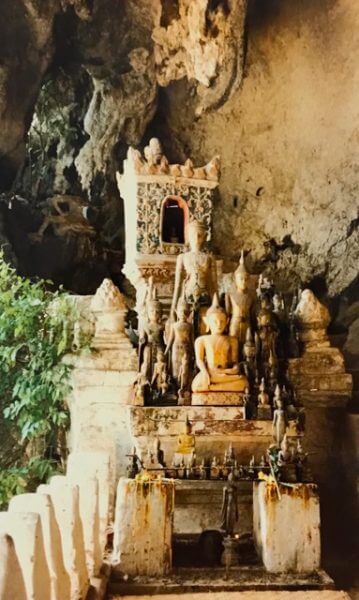 That night, we had a sensational storm, with high winds and lightening of all types — sheet, air-to-ground, ground-to-air, and even horizontal. There were single strikes, multiple strikes and branching strikes, different ranges lit up by different flashes. We’d never seen anything like it, although we’ve been told, and read, that such storms are typical of the Laotian mountains. In fact, there are apparently worse ones. We thought it was almost the highlight of the trip.
That night, we had a sensational storm, with high winds and lightening of all types — sheet, air-to-ground, ground-to-air, and even horizontal. There were single strikes, multiple strikes and branching strikes, different ranges lit up by different flashes. We’d never seen anything like it, although we’ve been told, and read, that such storms are typical of the Laotian mountains. In fact, there are apparently worse ones. We thought it was almost the highlight of the trip.
On our last day, we were to leave around 4:00, but the guide arrived at 8 a.m. to say the departure was rescheduled for 9:30. We rushed to pack and eat breakfast. Then he came to say it was leaving at 11:30. So we went to climb the 328 steps up Mt. Phoussey in the middle of the city. We visited the golden stupa at the top, with impressive views of town and environs. When we got down, the manager of Lao Tourism appeared, reporting that the plane would leave at 12:30, so we went back to our hotel for a cold drink. I elected to rest and read, while R and the guide took a fast trip to the old French cemetery, now in ruins and used by the local village as a clothes-drying yard and latrine. When R returned, we had an early lunch of fried Mekong fish, papaya and French bread. The plane finally took off at 1:00, loaded down with Chinese who ignored the “No Smoking” signs. This mixup in travel is typical of Third World voyaging, and we took it as part of the entertainment. “It’s more important to journey hopefully than to arrive.”
It was a good trip. We got out of town and saw a very special place. Even if Luang Prabang has seen better days, we all believe that it has a brighter future. We had lots of adventures, seeing things that are passing from this world. Not a bad way to spend five days.
***
[You may recall from an earlier post that Russell was to lead his Lao team on a study-tour to Kuala Lumpur, with me along to prep an article on that city for the Fredericksburg paper. We’d planned to go a few days early so we could sightsee together before the team arrived. But best laid plans…]June 21, 1991
Kuala Lumpur, Malaysia
We were supposed to have left on Sunday, but the official invitation from the Malaysian Government to the Lao didn’t arrive until Wednesday morning. We could have gone without the invitation, but the Lao couldn’t, and we didn’t want to start until we knew they were coming on this important learning experience for the team.
Russell called at 9:15 a.m. on Wednesday to say the cable had come from KL to the Malaysian embassy here. We decided to try to make the Lao Air flight that afternoon to Bangkok with a connection to KL that evening. We’d lost out on all but one day of our holiday, but we’d by gosh have that one day.
I hurried to pack for two people for a week in the big city, while R happily informed his team that they’d travel the next day, as planned. R then rushed to the bank for U.S. currency and to the airline for tickets to Bangkok.
We grabbed some cheese and crackers and headed for the airport. We’d heard that flying Lao Air was to be avoided, and now we know why. The plane is Soviet-built, a two-engine jet that probably wasn’t a treat when it was new. And it’s not new now. The seats were so close together, R experienced severe discomfort. We were unable to sit together, which was especially bad because it was a bumpy flight — it helps to hold hands with the one you love when the plane is jumping around in the sky. The a.c. created condensation, so there was mist blowing throughout the cabin during the 1-1/2 hour flight. We survived. It could have been more pleasant, but we survived.
It’s extremely difficult to book international tickets in Vientiane for flights beyond Bangkok. Best practice: call a Bangkok travel agent to make your reservations and meet you, if necessary, at the airport with your tickets, hotel voucher, etc. That’s what we’d done, but when we got to Bangkok, no travel agent. The connection was really tight, but the ticketing agent said she could get us on the flight. We didn’t know if we had a KL hotel reservation for that night or if the travel agent was somewhere in the airport searching for us. R found a pay phone and called the travel agent, while I worked with the ticketing agent to secure a booking, transfer our baggage, etc.
All of a sudden, it seemed to me that we were having more hassle than the whole thing was worth. So I asked the ticketing agent to hold the fort while I searched for R, finding him on the phone with the travel agent. We talked over the idea of staying overnight in Bangkok, having a quiet dinner and a good sleep and meeting our team’s flight from Vientiane and going on to KL together. After what we’d been through that day — I haven’t relayed half the trying details — it sure sounded good. R asked the travel agent to book us into the hotel across the street from the agent’s office and to bring our tickets there for the next day’s flight, as well as to change our week’s reservations in KL. The Malaysian government had booked 3 single rooms for us there, when we really needed a double for us and a business suite for team meetings.
The next day, after a morning excursion to one of the old Thai palaces, we checked in for our flight at noon, had a nice lunch and met our Lao colleagues’ flight from Laos. We all flew to Kuala Lumpur together, another hour-and-a-half in the air and one hour back in time, even though KL is almost directly south of Vientiane.
We were impressed with Kuala Lumpur from the minute we got off the plane — modern airport, efficient passenger services, driving along freeways set in greenbelts. They even have a dedicated lane for motorcycles, separate from the freeway, avoiding the danger of getting in each other’s way.
Kuala Lumpur is a beautiful city. Right now, it’s a wonderful blend of history and modernity. They’ve preserved the old colonial buildings, which are quite 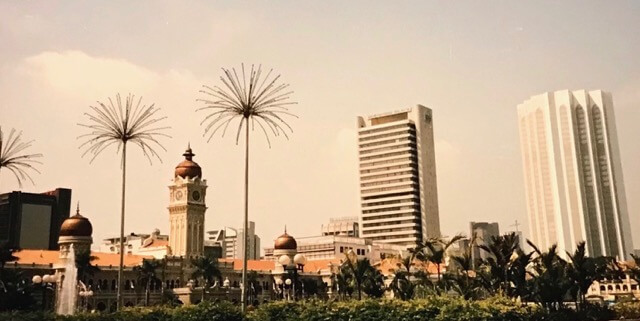 impressive, as well as historical mosques, temples and churches from the four main religions there — Islam, Buddhism, Hinduism and Christianity.
impressive, as well as historical mosques, temples and churches from the four main religions there — Islam, Buddhism, Hinduism and Christianity.
And they have also built quite attractive modern skyscrapers, which right now are not too close together. There’s nothing like the canyons of New York or the clogged streets of Bangkok. Instead, there’re lots of parks and open spaces and tree-lined streets. How long will this last? It’s perhaps revealing that everyday the KL paper had some story about another open area being built upon despite local expressions of concern. It may be that we visited KL at just the right time, when it was poised between the old and the new, urban enough to provide many services but young enough to still be on a human scale.
R and his Lao colleagues had an excellent professional visit. Malaysia is thought to be a good example of how to develop a modern economy without getting ripped off by local or foreign investors. Twenty years ago, it was like Laos is now, basically an undeveloped country as far as the economy and many basic services were concerned. In two decades, they have come from the colonial into the current era. Barring unforeseen difficulties, they should “graduate” soon into the ranks of modern Asian societies like South Korea, Taiwan, Hong Kong and Singapore.
While the team made their rounds, I had a good time sightseeing and shopping. In Vientiane, we do without a lot of things, so it was nice to be in a city with department stores, malls and supermarkets. To give you an idea, here’s a partial list of purchases: cornmeal, strawberry jam, tomato soup, strong plastic coat hangers, casserole dish, large serving platter, dessert dishes, plastic containers, small flashlight, Elizabeth Arden and Body Shop cosmetics, lots of paperbacks.
During the weekend, we were able to go shopping and sightseeing together. R got three shirts and a very dapper straw hat, while I bought some skirts, a batik jacket and a couple vests. We toured a large compound with demonstrations of crafts from different provinces and visited the national museum, full of fascinating displays about Chinese wedding customs, Malay sultans’ official attire, shadow puppets, jewelry, headgear and lots more. Later, we took a self-guided walking tour of the original city center.
I wanted to visit Malacca, the oldest city in Malaysia. About 500 years ago, it was rich and famous because it was located at the beginning and end of the monsoon cycle and controlled the main sea passage from East to West. It became a major trading city with goods passing through from China, India, the Philippines, South America, Africa and Europe. Many of the old buildings still stand, and it’s supposed to be a great place to see antiques.
 Despite my strong desire to just get on a local bus and go, I was repeatedly told that was a bad idea and to join a tour for safety’s sake. Not knowing enough about local safety issues, I elected the tour, which turned out to be a major tourist scam. They spent more time taking us to commercial establishments than to historical sites. All the tour members were unhappy, but there wasn’t much we could do about it. We didn’t stop at all for Jonker Street’s famous antique shops. They took us to a colonial church and the former Dutch statehouse when both were closed. The rest of the historical places were hurried through so we could get to various modern commercial tourist traps in the hopes that we would buy something with the tour company getting its commission. None of us bought anything in those traps. You expect a little commercialism on a tour, but this one was outside all reasonable bounds. If I’m ever back in Malaysia, I’ll go to Malacca on my own, stay overnight, and see things at my own pace, sans guide, with a guide book.
Despite my strong desire to just get on a local bus and go, I was repeatedly told that was a bad idea and to join a tour for safety’s sake. Not knowing enough about local safety issues, I elected the tour, which turned out to be a major tourist scam. They spent more time taking us to commercial establishments than to historical sites. All the tour members were unhappy, but there wasn’t much we could do about it. We didn’t stop at all for Jonker Street’s famous antique shops. They took us to a colonial church and the former Dutch statehouse when both were closed. The rest of the historical places were hurried through so we could get to various modern commercial tourist traps in the hopes that we would buy something with the tour company getting its commission. None of us bought anything in those traps. You expect a little commercialism on a tour, but this one was outside all reasonable bounds. If I’m ever back in Malaysia, I’ll go to Malacca on my own, stay overnight, and see things at my own pace, sans guide, with a guide book.
 [I did manage to enjoy the reconstruction of the sultan’s palace, despite our being allowed only 30 minutes to explore on our own. Made of teak with traditional naga-guarded roofs, it was open to the breezes (no a.c. in those days) and featured furniture and costumes from the original palace’s glory days. There was so much to see, I could easily have spent twice the allotted time, if not more.]
[I did manage to enjoy the reconstruction of the sultan’s palace, despite our being allowed only 30 minutes to explore on our own. Made of teak with traditional naga-guarded roofs, it was open to the breezes (no a.c. in those days) and featured furniture and costumes from the original palace’s glory days. There was so much to see, I could easily have spent twice the allotted time, if not more.]
The tour to Malacca was basically the only negative thing that happened. We came back much refreshed from our 9 days away, and we’re now enjoying our own bed, with cornmeal pancakes for breakfast. It’s good to go away, and it’s good to come home. Great to read all the mail, too. Write more when you can.

COMING NEXT MONTH
Touristing in Southeast Asia
Singapore, Jakarta and Phuket

LET ME HEAR FROM YOU.
Please take a moment to share your thoughts.
Your comments help make the blog better, and I always answer.
* * *
If you enjoyed reading this post, I hope you’ll SUBSCRIBE by clicking on the button below. Every month, when I post a new excerpt from my life overseas, you’ll get an email with a link so you can read the next installment. Subscription is free, and I won’t share your contact information with anyone else. Your subscribing lets me know you’re reading what I write, and that means a lot.

